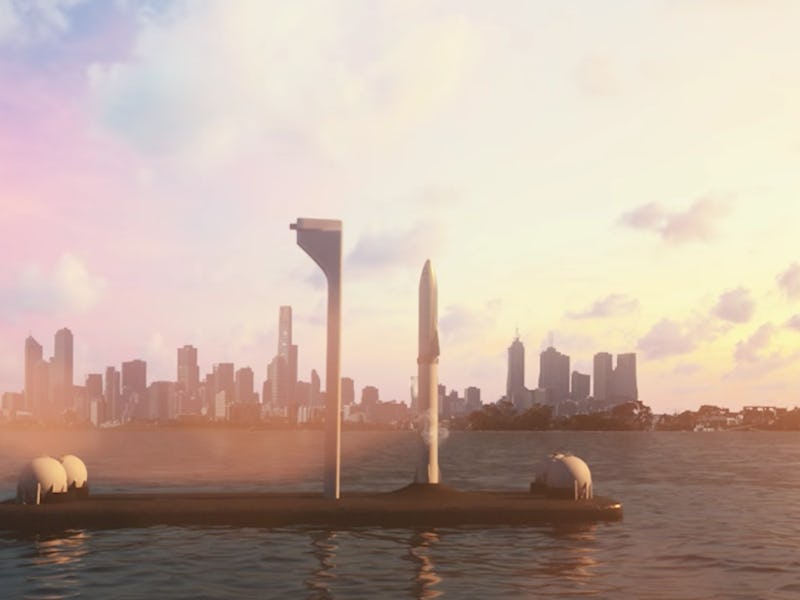SpaceX Starship: Those 30-Minute, Cross-Planet Flights Will Be Punishing
But on the other hand, it will also be very fast.

SpaceX wants to send you around the world in less than half an hour — if you can stomach the speed.
The space-faring firm is currently developing the Starship, a stainless steel behemoth designed to send the first humans on a mission to Mars. Another use for the vehicle, aimed at improving its feasibility as a profit-making machine, is point-to-point trips around the Earth.
The sheer power of the rocket is enough to enable a trip from New York to Paris, which takes around seven hours 20 minutes by plane, to take just 30 minutes. But of course, the incredible speed means the firm will have to cut back on some of the creature comforts provided to regular air passengers.
“Probably needs a restraint mechanism like Disney’s Space Mountain roller coaster,” Musk warned on Twitter Thursday. “Would feel similar to Space Mountain in a lot of ways, but you’d exit on another continent.”
If you can handle it, it could drastically reshape humanity’s concepts of time and space.
The Starship on Mars.
SpaceX Starship: What It Will Be Like to Ride
Musk first detailed the predecessor to the current design, the BFR, at a special conference in September 2017. The vehicle is designed with a pressurized cabin volume of 825 cubic meters, bigger than an Airbus A380 jet plane. On a Mars trip, Musk detailed how you could fit 40 cabins in the cargo area, fitting a maximum of six or about two or three for comfort.
In total, that comes to around 120 people flying to Mars at once. Considering the A380 flies with somewhere between 407 and 615 seats depending on the airline, that makes for an impressively roomy experience. It’s ideal for a Mars voyage set to take three to six months.
Unfortunately, Earth-bound trips won’t be so comfy. Musk has instead suggested that each flight would take around 1,000 people. Every seat would be “coach” basic travel. There would be no toilets, or food area, or pilot area.
“It’s basically an ICBM traveling at Mach 25 that lands,” Musk stated on Twitter.
Because Musk estimates that each trip will take around 15 to 20 minutes, it’s arguably not necessary to offer such amenities on these short trips. But SpaceX is essentially asking people to sign up for packing themselves like sardines into a giant tin hurdling as fast as a ballistic missile.
SpaceX Starship: Earth-to-Earth Journey Times Will Be Short
For those brave enough to take the trip, here’s how long SpaceX’s website says a trip will take:
- Los Angeles to New York, which normally takes five hours 25 minutes, will take 25 minutes.
- Bangkok to Dubai, which takes six hours 25 minutes by plane, will take 27 minutes.
- Tokyo to Singapore, which can take seven hours 10 minutes, would take just 28 minutes.
- London to New York, a seven hours and 55 minutes plane ride, takes just 29 minutes.
- New York to Paris, which takes around seven hours 20 minutes by plane, would take just 30 minutes.
- Sydney to Singapore, an eight hours and 20 minutes plane ride, would take 31 minutes.
- Los Angeles to London, a journey that normally takes 10 hours and 30 minutes, would take 32 minutes.
- London to Hong Kong, a ride that normally takes 11 hours 50 minutes, would take 34 minutes.
How much would a ticket cost? Sam Dinkins, writing for the Space Review, estimated in October 2017 it would cost over $1 million to transport 853 passengers, working out to $1,200 per person.
Musk has also suggested that it could link up with the hyperloop, his design for a vacuum, sealed pod transit system moving up to 700 mph. That would mean trips from the spaceport to the city center in under 10 minutes.
Hyperloop has yet to see any public deployments, and an orbital Starship prototype isn’t expected until next year. But if SpaceX delivers on its promise to build one new Raptor engine every 12 hours by the end of this year, it could provide the 38 engines needed for each Starship in record time. That could pave the way for intercontinental travel sooner than expected.